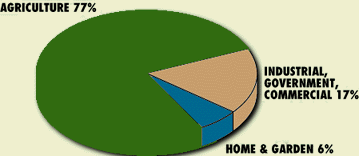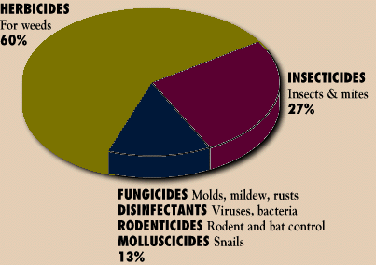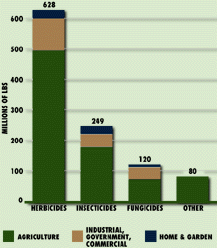




Almanac Table of Contents | Pesticides Table of Contents | TEC Home Page

This focus discusses the environmental impact of pesticide use in agricultural and urban settings. It does not explore the economic pros and cons of using pesticides, which is beyond the scope of the Texas Environmental Almanac.
Widespread use of synthetic pesticides in the United States began following World War II. The ingredients for many of today's pesticides were, in fact, created as weapons of war.(1) Before the development of synthetic pesticides, farmers used naturally-occurring substances such as arsenic and pyrethrum.(2) Pesticide use was credited with increasing crop yields by reducing natural threats to production and became an integral part of agricultural practices by the mid-1950s. During the past five decades, American agriculture has dispersed 30 billion pounds of pesticides into the environment.(3) Also, beginning in the late 1940s, federal and local governments sponsored the widespread spraying of DDT and other chemicals in urban communities in an effort to eradicate mosquitoes, fire ants, gypsy moths, the Japanese beetle and other insects judged to be harmful.
Every year in the United States, 1.1 billion pounds of active pesticide ingredients are released into the environment; 834 million pounds (77 percent) are used in agriculture, the remainder for non-agricultural purposes. If the use of wood preservatives, disinfectants and sulfur is included, the annual amount of pesticide usage increases to 2.2 billion pounds of active ingredients.(4) Altogether, U.S. pesticide usage equals more than four pounds per person annually.(5) In addition, the Environmental Protection Agency estimates that in 1991, U.S. manufacturers exported 390 million pounds of pesticides.(6)
Following World War II, pesticides were a component of what was predicted to be a "green revolution" of abundant food for the world. During the past fifty years, agricultural production in many areas of the world has increased dramatically, partly because of the use of herbicides and insecticides. Health benefits, such as those related to eradication of malaria-carrying mosquitoes, were also foreseen and, in many cases, attained.
In May 1962, biologist Rachel Carson alerted the public to the side effects of pesticide use in her book, Silent Spring. Questions were raised about the actual (rather than the perceived) benefits of pesticides, along with questions about environmental and public health risks.(7)
The "pathways" of human exposure to pesticides, which include insecticides, herbicides, rodenticides and fungicides, are numerous. Pesticide residues are found virtually everywhere: in the office and home, on food, in drinking water and the air.(8)
Throughout almost 50 years of pesticide use, most pesticides have never been systematically reviewed for their full range of long-term health effects on humans, such as potential damage to nervous, endocrine or immune systems. The Environmental Protection Agency considers only cancer in determining the potential threat of pesticides to human health. Until recently, cancer has been considered the most sensitive end point - if you could prevent cancer, you could prevent other chronic diseases. Furthermore, scientists have been able to develop the model by which they can extrapolate cancer data from animal studies. The concept that cancer is the most sensitive end point is now being seriously questioned. Though not documented, estrogenic changes might be another sensitive end point.
The effects of pesticides on wildlife are also not well-documented. It wasn't until 1985 that the EPA reviewed an insecticide solely on the basis of its effects on wildlife.(9) Since then, the EPA has canceled some pesticides, based partially on their effects on the environment and wildlife.(10) Discoveries of pesticide residues have also resulted in fishing bans in bays, lakes and rivers.
Agricultural pesticides have prevented pest damage at between 5 percent and 30 percent of "potential production in many cropping situations."(11) Pesticides, however, have posed a number of problems for agriculture, including the killing of beneficial insects, secondary pest outbreaks and the development of pesticide-resistant pests.(12) Several studies show a decrease in the effectiveness of pesticides. According to one study, 7 percent of U.S. agriculture production was lost to pests in the 1950s; in 1993, 13 percent of all production was lost to pests.(13) A different study concluded that crop losses from pests increased from 31 percent in 1945 to 37 percent in 1990 while during that same period farmers used 33 times more pesticides.(14)
Today, 440 species of insects and mites and more than 70 fungi are now resistant to some pesticides.(15) As a result, it has become necessary to use larger doses and more frequent applications of pesticides. Combining pesticides, or substituting more expensive, toxic or ecologically hazardous pesticides occurs more frequently. In addition to the problem of pesticide resistance, millions of dollars worth of crops have been lost as a result of improper pesticides application.(16)

Source: Environmental Protection Agency, Pesticide Industry Sales and Usage: 1990-1991 Market Estimates (Washington, DC: EPA, Office of Pesticide Programs, Fall 1992) 10.
Although pesticides do offer certain benefits for farmers and other users, new scientific research is uncovering some important health-related issues associated with their use. Recently, for example, some scientists have become convinced that there is a relationship between pesticides that mimic the estrogen hormone and the disruption of the endocrine system in humans and wildlife. This potentially could contribute to serious health problems, including breast and other types of cancer in humans, and reproductive disorders.(17) Currently, in registering pesticides, the EPA does not require tests for estrogenicity, and if a pesticide were found to be estrogenic, the EPA would have no method of removing it from the market.
Estrogenic pesticides include:
Though there is no conclusive evidence to date, in the last few years several studies have indicated that chemicals which mimic the female hormone estrogen might cause reproductive problems in animals. For example, one study has reported that male alligators exposed to pesticides in Florida are having difficulty reproducing, partly because their penises are not developing to normal size. This reproductive interference could be related to exposure to estrogenic pesticides. It also has been reported that some birds, fish, amphibians, and mammals are being "feminized" by exposure to low levels of pesticides and other industrial chemicals.(19)

Source: Texas Water Commission, Groundwater Quality in Texas, Report 89-01, March 1989.
| PESTICIDE FAMILIES |
|---|
|
The three major families of pesticides are:
Chlorinated hydrocarbons or organochlorines. These pesticides break down chemically very slowly and can remain in the environment for long periods of time. Dieldrin, chlordane, aldrin and helptachlor are pesticides of this type. Organic phosphates or organophosphates. These pesticides are highly toxic to humans but do not remain in the environment for long periods of time. Parathion, malathion, thimet and trichlorphone are pesticides of this type. Carbamates compounds. These pesticides are considered highly toxic to humans. Source: Nancy Blanpied, editor, Farm Policy, the Politics of Soil, Surpluses, and Subsidies (Washington, DC: Congressional Quarterly Inc., 1984), 69. |

Source: Environmental Protection Agency, Pesticide Industry Sales and Usage: 1990-1991 Market Estimates (Washington, DC: EPA, Office of Pesticide Programs, Fall 1992) 11.
In 1947, Congress took its first step to regulate pesticides with the enactment of the Federal Insecticide, Fungicide and Rodenticide Act (FIFRA). This early law was intended primarily to protect farmers and others from mislabeled, ineffective or adulterated pesticides. That original document was only 35 pages long. By 1994, with billions of dollars on the line and as questions of possible adverse health effects and environmental impacts had been raised, FIFRA has expanded to more than 200 pages.(20) FIFRA initially granted jurisdiction over pesticides to the United States Department of Agriculture, but in 1970, amid reports of the USDA's mismanagement and conflicts of interest, Congress shifted authority for pesticide regulation to the newly-created Environmental Protection Agency (EPA).(21) The USDA, however, continues to play a role: it is responsible for monitoring pesticide residues and it continues to promote the use of pesticides.
Key provisions of the current version of FIFRA include the following:(22)
| ENDOCRINE DISRUPTORS WIDELY USED IN AGRICULTURE | |||
|---|---|---|---|
| PESTICIDE | TOTAL POUNDS | ACRES TREATED | NUMBER OF CROPS |
| Benomyl* | 1,309,602 | 1,762,398 | 40 |
| Mancozeb* | 8,229,524 | 2,082,382 | 20 |
| Maneb* | 3,355,165 | 845,309 | 19 |
| Metriam* | 620,887 | 106,277 | 2 |
| 2,4-D* | 33,080,430 | 66,810,477 | 29 |
| Alachlor* | 55,025,302 | 27,664,772 | 8 |
| Atrazine* | 63,946,010 | 48,977,866 | 7 |
| Metribuzin | 4,792,291 | 12,939,781 | 12 |
| Trifluralin* | 27,005,685 | 33,241,615 | 42 |
| Carbaryl | 7,238,350 | 4,564,697 | 63 |
| Dicofol* | 1,701,807 | 1,170,336 | 19 |
| Endosulfan | 1,926,063 | 1,369,439 | 48 |
| Methomyl | 2,800,176 | 4,788,309 | 59 |
| Methoxychlor | 107,722 | 102,025 | 12 |
| Parathion | 8,054,264 | 8,135,356 | 45 |
| Permethrin* | 1,103,362 | 6,018,470 | 41 |
| Cypermethrin* | 183,897 | 1,564,392 | 6 |
| Fenvalerate | 71,286 | 400,362 | 27 |
| Esfenvalerate | 277,950 | 4,216,675 | 40 |
| Total | 220,829,773 | 226,760,938 | 68 |
| *Classified as a possible or probable human carcinogen by the EPA. | |||
| Source: Environmental Working Group. Compiled from Resources for the Future: "Insecticides in US Crop Production," "Fungicides in US Crop Production," and "Herbicides in US Crop Production." | |||

NEXT PAGE Go to page 1*2*3*4*5*Notes

Please send questions, comments, or problems with this page to ltarver@mail.utexas.edu..